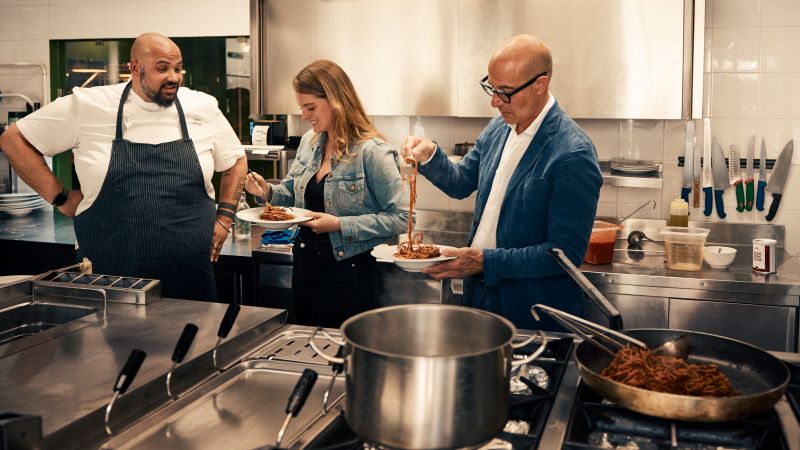Editor’s Note: “Stanley Tucci: Searching for Italy” is available now on CNNgo and Discovery+.
CNN
—
You’ll no doubt be hungry after watching the wanderlust-inducing “Stanley Tucci: Searching for Italy.”
Every episode is chock-full of mouthwatering regional specialties prepared by chefs all over the country.
For those wanting to follow in Stanley Tucci’s footsteps, below is an episode-by-episode guide to all the restaurants — including local hangouts and Michelin-starred establishments — the actor visited during the show’s second season.
The Italian Riviera is widely considered to be the most glamorous and picturesque coastline in Europe. Portofino and Cinque Terre, located in Liguria, are two of Italy’s most visited destinations. With its steep cliffs and wild countryside softened by sporadic villages of candy-colored houses, this idyllic strip of mountainous land has breathtaking views. The harshness of the land has made the people inventive. It’s Liguria we have to thank for pesto, one of Tucci’s favorite things.

‘Don’t laugh at me’: Tucci makes traditional ravioli
Cracco Portofino is run by Carlo Cracco — one of Italy’s most famous, Michelin-starred chefs. His menu features dishes that are linked to the land. For Tucci, he cooked the traditional Ligurian dish of ravioli-like pansotti pasta with a mixture of greens and herbs called preboggion and walnut sauce. “It’s very different than anything I’ve ever tasted,” Tucci said as he raved about the meal.
Il Genovese is known for its pesto, which is crushed by hand in an ancient mortar. Chef Roberto Panizza, known as the King of Pesto and the founder of the Pesto World Championship, made Tucci a pasta dish to showcase the delectable green sauce. He added green beans and potatoes to the pasta to make it extra creamy. “So humble, this dish. So humble, just like me,” Tucci joked.

‘This is going to blow your mind’: Tucci challenged to dip his focaccia
Antico Forno della Casana makes some of the best focaccia in the region, according to food writer Laurel Evans. The bread with its signature dimples is a working-class staple that originated in Genoa. The local trick is to eat it upside down so the salt hits your tongue first and the rest of the flavors follow.
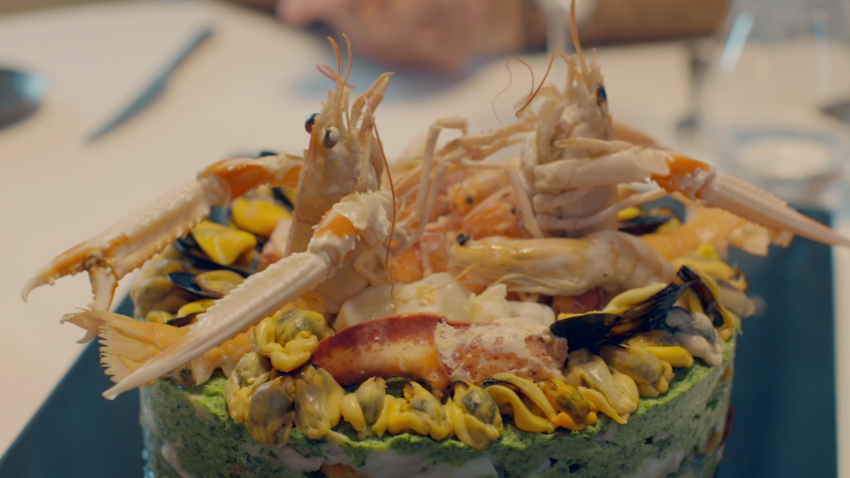
Feast your eyes on the most elaborate salad you’ve ever seen
The Cook is the hot new restaurant of chef Ivano Ricchebono that is situated in a 14th-century palazzo in Genoa. “Wow! Wow! Wow!” Tucci exclaimed as he walked inside and took in the architecture. Ricchebono specializes in seasonal and local ingredients. Tucci came to try corzetti, a Genoese pasta, and cappon magro, an ornate seafood dish. When cappon magro hit the table, Tucci was in awe of the presentation.
Ittiturismo, built into the cliffs of Cinque Terre, is both a family home and their restaurant. The head chef is the son, Pietro Galletti, who cooks the fresh fish foraged by his father, Guido. Tucci joined the family for lunch on their terrace. They feasted on pasta with fish sauce and fried anchovies stuffed with cheese and herbs then covered in breadcrumbs.
Puglia is famous for its fragrant olive oil, beautiful vegetables, delicious cheeses and flavorful durum wheat. Frequently called the boot of Italy, this southern region represents the nation’s culinary scene at its most fundamental — simple, fresh, locally produced cuisine. Despite being one of Italy’s poorest regions, Puglia is coming into its own, and Tucci discovers that there’s a newfound pride in its gastronomic roots.

Tucci: This goes against everything I know about pasta
At Urban Bistrot in Bari, chef Celso Laforgia cooks up pasta all’assassina (assassin pasta). The spicy and charred dish is made by putting the pasta in a pan with olive oil and spices — but no water — until it’s burnt and crispy. “Honestly, I’ve never seen anything like that before,” Tucci said. “And I’ve been around too.” According to Laforgia, the dish got its name after the first person who tried it called the chef a killer because it was so spicy.
With a name that means “ancient flavors,” Antichi Sapori in Montegrosso is known for transforming simple, humble ingredients into world-class cuisine. Such is the case with its signature dish, burnt gain orecchiette in a fava bean cream served with burrata cheese and charred black olives. Fava beans are a favorite in Puglia; they add a smooth, creaminess to the pasta. “It’s the balance of flavors,” said chef Pietro Zito as he served the dish to Tucci. “That’s amazing,” Tucci said. “Now, I can’t stop eating.”
Trattoria Bere Vecchie, tucked in the labyrinth of alleyways of the hilltop town of Cisternino, is a butcher shop that doesn’t just sell meats, it cooks them on the spot. The shop is run by young restaurateur Vito Zurlo. Historically, this building was a pharmacy, now it serves up meat spit-roasted in a way reminiscent of Turkish style kebabs. Tucci tried bombette (rolls of pork stuffed with cheese, herbs and red pepper) and gnumareddi (lamb wrapped in intestines).
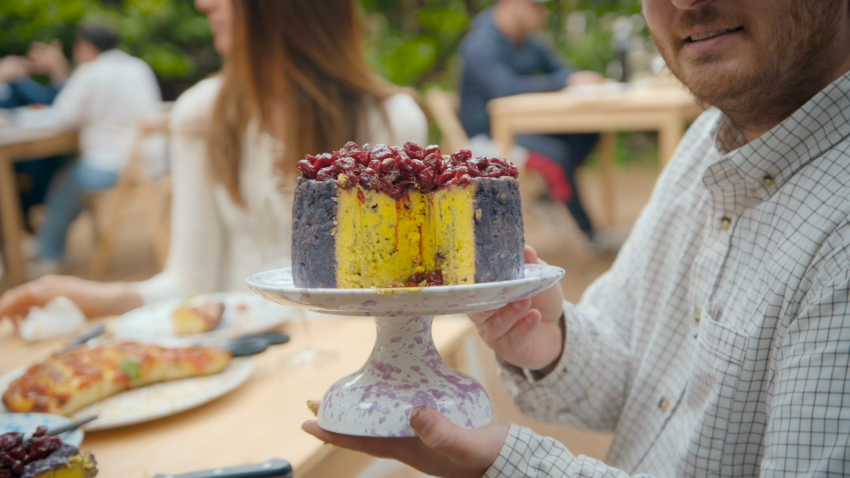
The color of this blue cheese shocks Tucci
Caseificio Dicecca is a one-of-a-kind cheese bar, where cheesemaker Vito Dicecca created something unprecedented in this region: Apulian blue cheese. Over time, he’s developed 66 different types of blue cheese. He served Tucci focaccia with burrata, which Dicecca’s mother use to make for his school lunches.
Ristorante Vitantonio Lombardo is an abandoned cave in the ancient town of Matera that’s been turned into a Michelin star restaurant. Chef Vitantonio Lombardo whips up dishes with inventive names like “I dropped the Egg in the Garden” and “Drone View of the Murgia.” For Tucci, he made “Poverty and nobility with a red wine sauce.” The dish is a veal filet and veal throat, or sweetbread, covered in black breadcrumb to look like a black truffle — a symbol of decadence. It’s then served with a potato puree and a red-wine reduction sauce. “That is f**king amazing,” Tucci said.
Sardinia is the most remote region of Italy. Cut off from the Italian peninsula, this island has developed its own customs and cuisine. Eating here is like going on the culinary equivalent of an archaeological dig since so many waves of settlers throughout history have influenced the food. While stopping here, Tucci discovered two sides to this fascinating region: the coast with its seafood and a dazzling mix of cultures drawn from around the Mediterranean; and the interior — a steep, rocky landscape where locals stubbornly cling to their ancient traditions and freedoms.
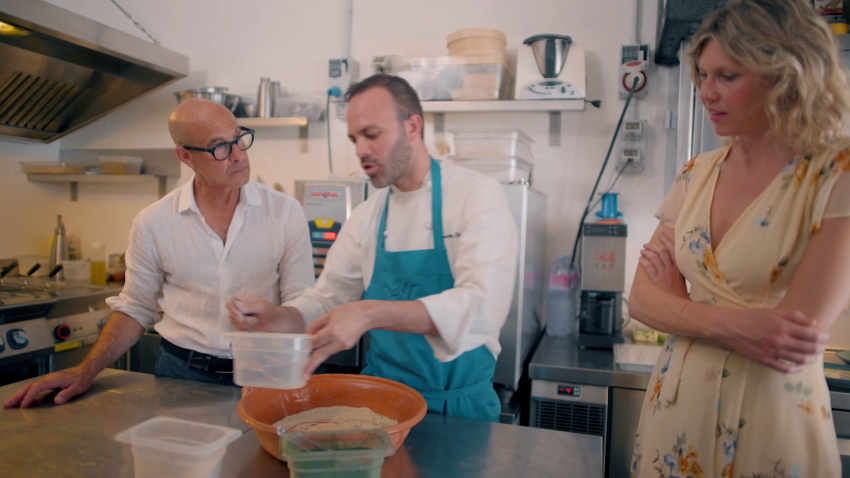
In ancient times if you didn’t know fregola, you weren’t wife material
Fradis Minoris gets its supply of fresh seafood daily from the surrounding waters. The restaurant’s sustainable menu earned it a coveted Michelin Green Star — the first in Sardinia. When Tucci swung by, chef Francesco Stara made fregola ai frutti di mare, a local staple. The star of the dish is the fregola, which is a North African-inspired, couscous-like pasta.
At Luigi Pomata, chef and owner Luigi Pomata is known as the king of tuna. Raw seafood, including tuna, takes center stage on his menu. During Tucci’s visit, Pomata cooked up local bluefin tuna with pesto in a traditional pasta dish called cassulli alla carlofortina. Much to Tucci’s surprise, Pomata prepares it by taking the fresh tuna belly and boiling it. “That’s delicious,” Tucci said after sampling the dish.
Al Forno, located in the medieval city of Alghero known as little Barcelona, is a small bakery. Tucci ordered panada — a type of Sardinian savory pie said to have received its name from empanada, a similar pastry dish thought to have originated in Spain. “Oh my God!” Tucci proclaimed. “It’s like Italy and Spain together in my mouth.”
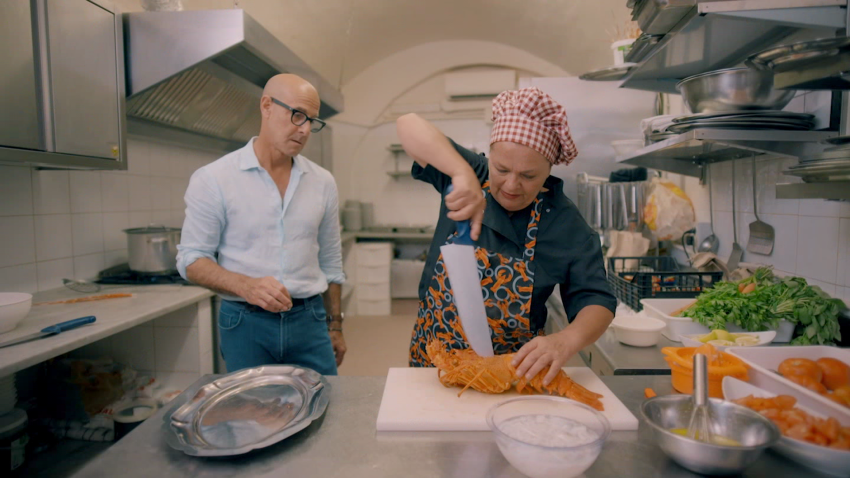
Saltier than the ocean, this region’s waters make its lobster some of the world’s best
Mabrouk is a former 16th-century monastery converted into a restaurant. Chef Antonietta Salaris works with the local lobster that’s known to be some of the best in the world. She makes the regionally popular lobster a la Catalana. In the US, lobster eggs are often thrown out, but Salaris adds them to the sauce for a salty sweetness. “That’s so f***ing delicious,” Tucci said.
Arimani, in the ancestral village of Battista in northern Sardinia, is a culinary school, so here you must cook your own lunch before feasting. Chef Simonetta Bazzu has devoted her life to preserving Sardinia’s traditional cuisine and ancient recipes. For Tucci, she made pane carasau — a thin, crispy bread dating back to at least 1000 BC — and a zuppa gallurese, pane carasau soaked in sheep broth, topped with heaps of cheese and wild mint and baked into the woodfire oven.
Of all the regions of Italy, Calabria holds the most meaning for Tucci. It’s his ancestral homeland and a place he had dreamed of visiting since he was a boy. “I want to get to know the region my family left behind,” Tucci said on the show. This wild, rugged region makes up the “toe” of the country’s boot-shaped peninsula. It’s known for its sprawling beaches, mountains and regional foods, including traditional salami, sweet red onions and chili peppers.
Panificio Cuti, run by baker Pina Olivetti, has been serving traditional Calabrian bread — a sourdough yeast bread called pane de cuti — since 1985. The spot is located in Marzi, which is known as the valley of wheat. When Tucci swung by the bakery, he tried pane di cuti, a 100-year-old recipe. For Tucci and his hungry parents, she also made morsello, a bread bowl filled with sausage and broccoli rabe. This portable meal was once a favorite among farmers and hunters who wanted to carry a not-so-little slice of home with them wherever they went. Today, this dish is often served at weddings and celebrations.
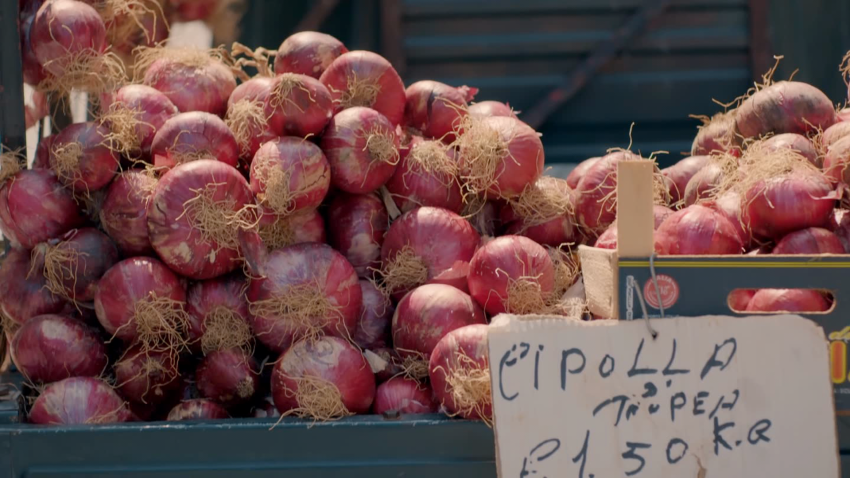
These red onions are so sweet that Italians turned them into ice cream
At Osteria della Cipolla Rossa (Red Onion Inn), run by Michele Pugliese and Romana Schiariti, the specialty is the unapologetically simple red onion spaghetti. The key ingredient is the region’s renowned sweet red onions, called cipolla rossa, which only grow along the small stretch of coastline surrounding the city of Tropea. The onions are so sweet that, during the episode, Tucci bit into a raw one as if it were an apple.
Il Principe di Scilla is a family-run restaurant in Scilla, Italy, that is all about the local swordfish, the most respected or prized sea creature in Calabria — and for a region surrounded by water on three sides, that’s really saying something. “It’s like prosciutto and smoked salmon had a love child,” Tucci said as he sampled the fresh raw swordfish with restaurant owner Johnny Giordano. Tucci also tried scialiatelli alla ghiotta, which is like a swordfish ragu. “It’s nothing short of incredible,” Giordano said of the pasta dish.
In the dishes at Qafiz, tucked in the Aspromonte mountains, chef Nino Rossi uses local ingredients. He prepared for Tucci the signature dessert that helped the restaurant snag a Michelin star: fire. Inspired by the idea of renewed growth after the 2021 wildfires, the aptly named dish is made of meringue flavored with charcoal, sliced apple and white chocolate foam. “It’s like a million different flavors in there,” Tucci said as he dove in for seconds.
La Collinetta, located in the mountain town of Martone, is run by farmer and chef Pino Trimboli. When Tucci visited, Trimboli made lamb in clay, an ancient Greek dish. The lamb is surrounded by wet clay before it’s baked to seal in the delicate flavors and juices. This ancient technique comes with a tradeoff: Each dish takes over four hours to cook. But Tucci said the resulting “fall off the bone” lamb was worth the wait.
Stay tuned for updates as Tucci travels to two more regions of Italy. Earlier this year, Tucci traveled to Piedmont, Umbria, Venice and London. For a guide to all the places he visited during season one, click here.
